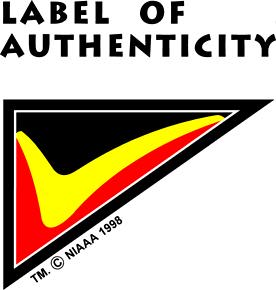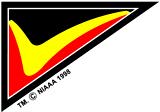
The Label of Authenticity Trade Mark Project
Some Questions and Answers
Why do we need these labels or trade marks?

As a quick way for consumers and retailers to know that art, crafts, souvenirs and other work is the authentic product of either an indigenous creator or a collaboration between indigenous creators and others, and not a 'rip-off'.
To provide a distinctive symbol that is the focus for efforts which create a real marketing advantage for authentic indigenous work.
As a platform for public education about authenticity, the 'rip-off' problem and the range of indigenous creative expression.
Why are there two different marks?

They are intended to convey quite different messages to the public.
The Label of Authenticity Mark says that any work to which that label is attached is the authentic work of an Aboriginal or Torres Strait Islander.
The Collaboration Mark says that any work to which this label is attached is the result of a collaboration in
which an Aboriginal or Torres Strait Islander has a significant creative input, and is the subject of a fair agreement with the non-indigenous manufacturer (eg. t-shirt producer) or other collaborator.
How do I distinguish the marks?

The marks look different - the Collaboration Mark is surrounded by a white border to reflect the involvement of non-indigenous people in the work or its manufacture.
Each of the marks must be accompanied in use with information about the relationship of the indigenous creator to
the work. In the case of the Collaboration Mark this will make it clear to consumers that there is non-indigenous input.
An indigenous creator who is certified to use the Label of Authenticity Mark can use that mark on all their work. The Collaboration Mark can only be used for the specific work (and mass production of that work) which has been certified.
Who can apply to use the marks?

Indigenous creators apply to be certified to use the Label of Authenticity Mark. Applications are accepted from today.
Both the indigenous creators and the non-indigenous people involved in the production of any product incorporating their work must join in an application for the use of the Collaboration Mark. The certified licensee of that mark will be the person who actually attaches it to products or services that are put onto the market. Applications to use the Collaboration Mark will be accepted in early 2000.
Does it cost to use the labels?

There is a small fee to cover the cost of processing each application together with a fee to cover the purchase of the labels themselves. In the case of the Authentic Collaboration Mark, there is also a licence fee for each product (eg. each t-shirt to which the mark will be applied). All fees will be used to cover the cost of managing the Label of Authenticity Project.
Who decides whether the
certification criteria are met?

The National Indigenous Arts Advocacy Association will be the owner of the mark and will administer the rules governing its use. It is a non-profit, independent body. It will make initial decisions on whether creators are Aboriginals or Torres Strait Islanders, after consultation with others where necessary or appropriate. Similarly, NIAAA will make the initial decision as to whether or not any collaboration is the subject of a fair agreement between indigenous creators and the non- indigenous people involved in the production of any work for which the Authentic Collaboration Mark is to be used.
What safeguards exist on the exercise of these certification powers?

The criteria have been made as objective as possible, as required by legislation and the Australian Competition and Consumer Commision. As to whether or not a creator is an Aboriginal or Torres Strait Islander, the criteria are those applied to similar decisions under ATSIC legislation (ie. descent from Aboriginals or Torres Strait Islanders, self-identification as an Aboriginal or Torres Strait Islander and acceptance as such within an indigenous community). In the case of the fairness of a collaboration, the criteria do not inquire into whether the amount of any payment is fair but rather concentrate on the existence of a number of objective criteria such as whether or not there is a written agreement, whether the artist had the opportunity to get independent advice, whether the terms are discriminating compared to any offered by the collaborator to white artists, etc.
NIAAA is required to give reasons in any case where it refuses certification.
In the event of any dispute regarding a decision made by NIAAA, there is provision for determination by an independent expert.
Are there limits on how the marks are used?

Yes, certified users must make sure that their use complies with a set of Rules that has been established for each mark.
The Rules require that each label mark be used in conjunction with a separate label which gives information about the indigenous creator and the production of the work. This will help educate consumers as to the range of indigenous culture, experience and expression.
Will the marks prevent stories and symbols from my country being taken and used by other indigenous artists?

NIAAA will not be certifying that artists or works are of any particular aesthetic quality or that they comply with cultural conventions, protocols etc.
However, a certified indigenous creator can lose the right to use the Label of Authenticity if they make use of stories, symbols, styles or the like without obtaining any necessary permissions from the people of the relevant country.
What things will the marks be used on?

The labels can be used on a very wide range of products and services. This will go well beyond recognisable,
traditional art and craft works to a very broad range of products and services which embody other modes of indigenous creative expression.
Could people copy the labels?

Not legally. The labels feature copyright artworks and are the subject of trade mark applications. NIAAA will be able to take actionfortrade mark infringementunderthetrade MarksAct(oncetheapplicationare registered)and/orcopyrightinfringement under the Copyright Act for unauthorised use of the labels. The Australian Competition and Consumer Commission can also take action under the Trade Practices Act for an unauthorised use of the labels.
Will the labels help stop the rip-offs?

Yes and no. A rip-off which does not attach a similar label will not infringe any right in the labels. However, if retailers and consumers are educated to look for the label as a symbol of authenticity when they want to buy the work of indigenous creators, then it will become more difficult to market and sell rip-off products.
Will the labels be successful?

Yes, if:
(a) they are embraced and used by indigenous creators who are selling works into the relevant consumer markets;
and
(b) there is a sufficient and effective marketing effort to generate consumer awareness and understanding of the labels and the role they can play in consumer buying decisions.
Will the labels detract from local or regional labels?

No. The labels can sit alongside any regional or local label. They will complement each other and improve the level of consumer education on these issues.
How do I apply to use the labels or get more information?

Contact NIAAA which has application forms, information packages, fee
schedules and other information on (02) 9331 3777 or visit the website
at niaaa.com.au
|
















